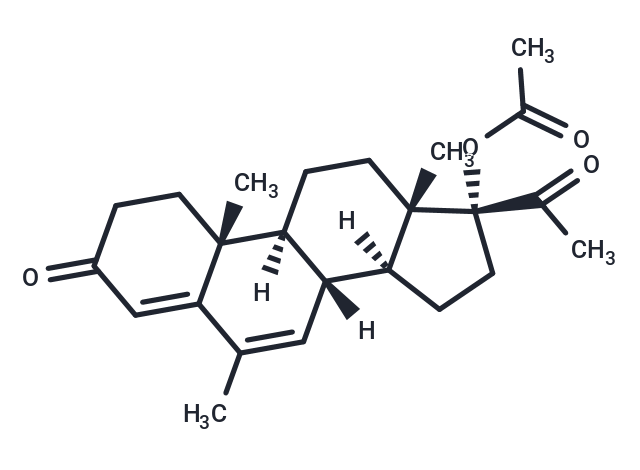Shopping Cart
- Remove All

Your shopping cart is currently empty


| Pack Size | Price | Availability | Quantity |
|---|---|---|---|
| 500 mg | $45 | In Stock | |
| 1 g | $57 | In Stock | |
| 1 mL x 10 mM (in DMSO) | $50 | In Stock |
| Description | Megestrol acetate (BDH1298) is a progestogen with actions and uses similar to those of the progestogens in general. Megestrol acetate also has anti-androgenic properties. It is given by mouth in the palliative treatment or as an adjunct to other therapy in endometrial carcinoma and in breast cancer. Megestrol acetate has been approved to treat anorexia and cachexia. |
| In vitro | Megestrol acetate inhibits the expression of cytoplasmic aromatase through nuclear C/EBPβ in reperfusion injury-induced ischemic rat hippocampus. [1] Megestrol acetate significantly increases the proliferation, migration, and adipogenic differentiation of adipose-derived stem cells (ASCs) in a dose-dependent manner. Megestrol acetate also upregulates genes downstream of glucocorticoid receptor (GR) in ASCs. [2] |
| In vivo | Megestrol acetate significantly decreases the circulating concentrations of estradiol (E2) and testosterone (T) in female fish or 11-ketotestosterone (11-KT) in male fish. Megestrol acetate exposure significantly downregulates the transcription of certain genes along the hypothalamic-pituitary-gonadal (HPG) axis. [3] Megestrol acetate produces a progressive deterioration in glucose tolerance, with a significant increase in mean fasting plasma glucose concentrations and decrease in mean plasma glucose clearance rates after 6 months and 12 months of treatment in cats. Megestrol acetate also produces a progressive decrease in both resting plasma cortisol concentrations and cortisol concentrations after ACTH stimulation in cats. [4] Megestrol acetate (50 mg/kg/day) for 9 days significantly increases food and water intake compared with untreated controls. Megestrol acetate (50 mg/kg/day) significantly (90-140%) increases in neuropeptide Y concentrations in the arcuate nucleus (where neuropeptide Y is synthesized), in the lateral hypothalamic area (through which arcuate neurones project) and in the medial preoptic area, ventromedial nucleus and dorsomedial nucleus in rats. [5] |
| Alias | SC10363, BDH1298 |
| Molecular Weight | 384.51 |
| Formula | C24H32O4 |
| Cas No. | 595-33-5 |
| Storage | Powder: -20°C for 3 years | In solvent: -80°C for 1 year | Shipping with blue ice. | |||||||||||||||||||||||||
| Solubility Information | Ethanol: 7.7 mg/mL (20 mM) DMSO: 10 mg/mL (26.01 mM), Sonication is recommended. | |||||||||||||||||||||||||
Solution Preparation Table | ||||||||||||||||||||||||||
Ethanol/DMSO
| ||||||||||||||||||||||||||

Copyright © 2015-2024 TargetMol Chemicals Inc. All Rights Reserved.